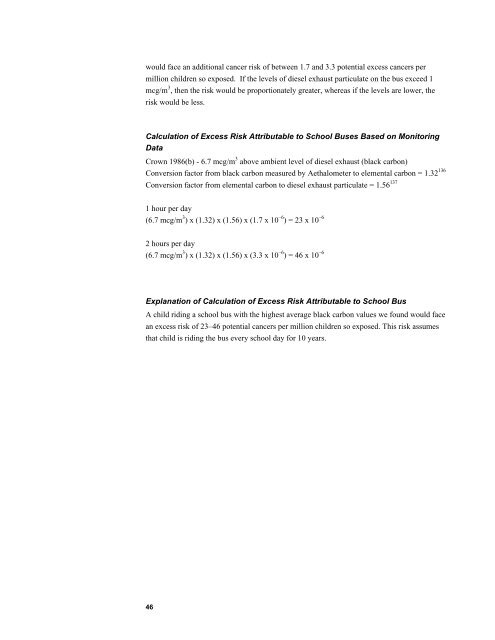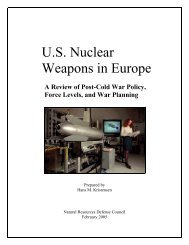NRDC: No Breathing in the Aisles: Diesel Exhaust Inside School ...
NRDC: No Breathing in the Aisles: Diesel Exhaust Inside School ...
NRDC: No Breathing in the Aisles: Diesel Exhaust Inside School ...
You also want an ePaper? Increase the reach of your titles
YUMPU automatically turns print PDFs into web optimized ePapers that Google loves.
would face an additional cancer risk of between 1.7 and 3.3 potential excess cancers per<br />
million children so exposed. If <strong>the</strong> levels of diesel exhaust particulate on <strong>the</strong> bus exceed 1<br />
mcg/m 3 , <strong>the</strong>n <strong>the</strong> risk would be proportionately greater, whereas if <strong>the</strong> levels are lower, <strong>the</strong><br />
risk would be less.<br />
Calculation of Excess Risk Attributable to <strong>School</strong> Buses Based on Monitor<strong>in</strong>g<br />
Data<br />
Crown 1986(b) - 6.7 mcg/m 3 above ambient level of diesel exhaust (black carbon)<br />
Conversion factor from black carbon measured by Aethalometer to elemental carbon = 1.32 136<br />
Conversion factor from elemental carbon to diesel exhaust particulate = 1.56 137<br />
1 hour per day<br />
(6.7 mcg/m 3 ) x (1.32) x (1.56) x (1.7 x 10 –6 ) = 23 x 10 –6<br />
2 hours per day<br />
(6.7 mcg/m 3 ) x (1.32) x (1.56) x (3.3 x 10 –6 ) = 46 x 10 –6<br />
Explanation of Calculation of Excess Risk Attributable to <strong>School</strong> Bus<br />
A child rid<strong>in</strong>g a school bus with <strong>the</strong> highest average black carbon values we found would face<br />
an excess risk of 23–46 potential cancers per million children so exposed. This risk assumes<br />
that child is rid<strong>in</strong>g <strong>the</strong> bus every school day for 10 years.<br />
46
















